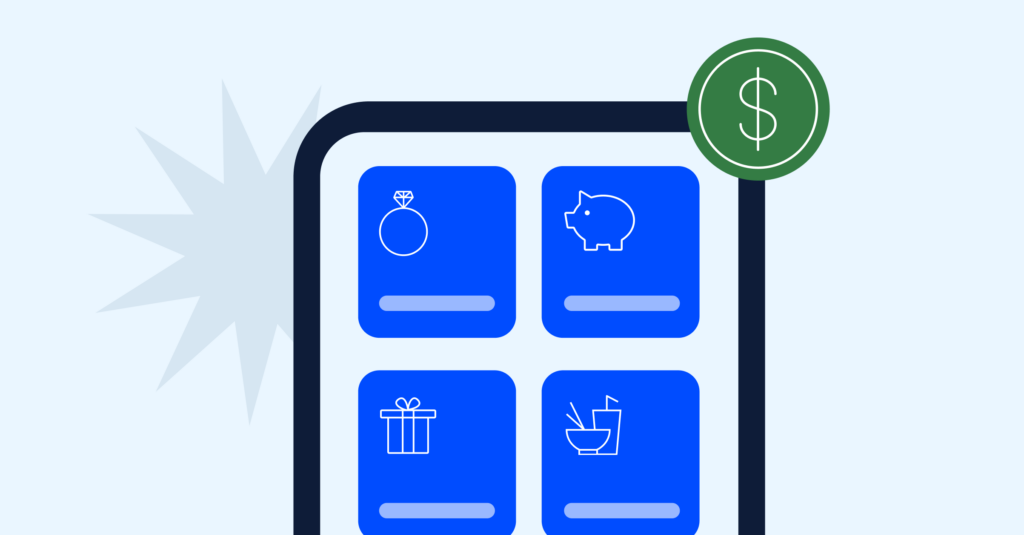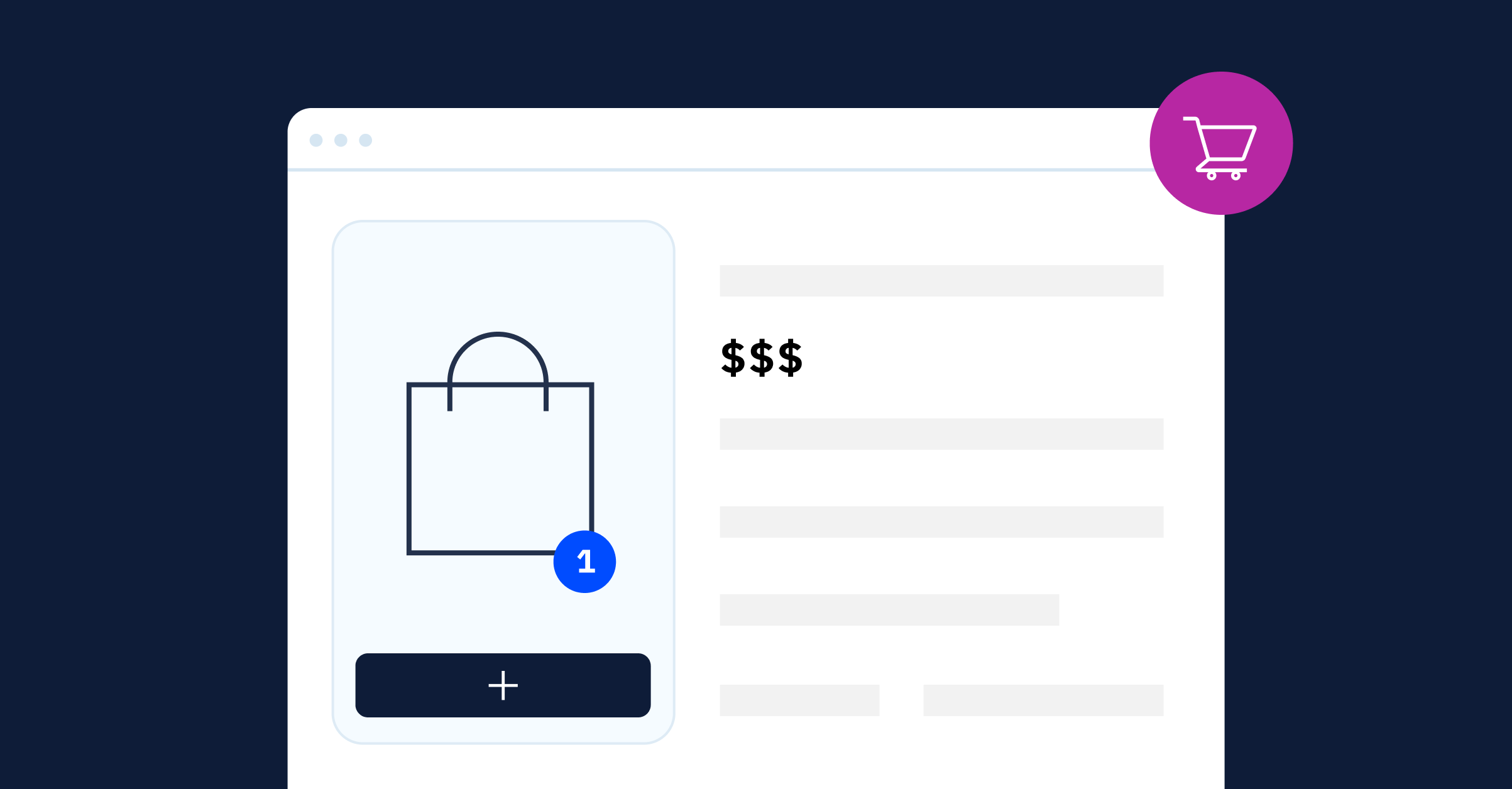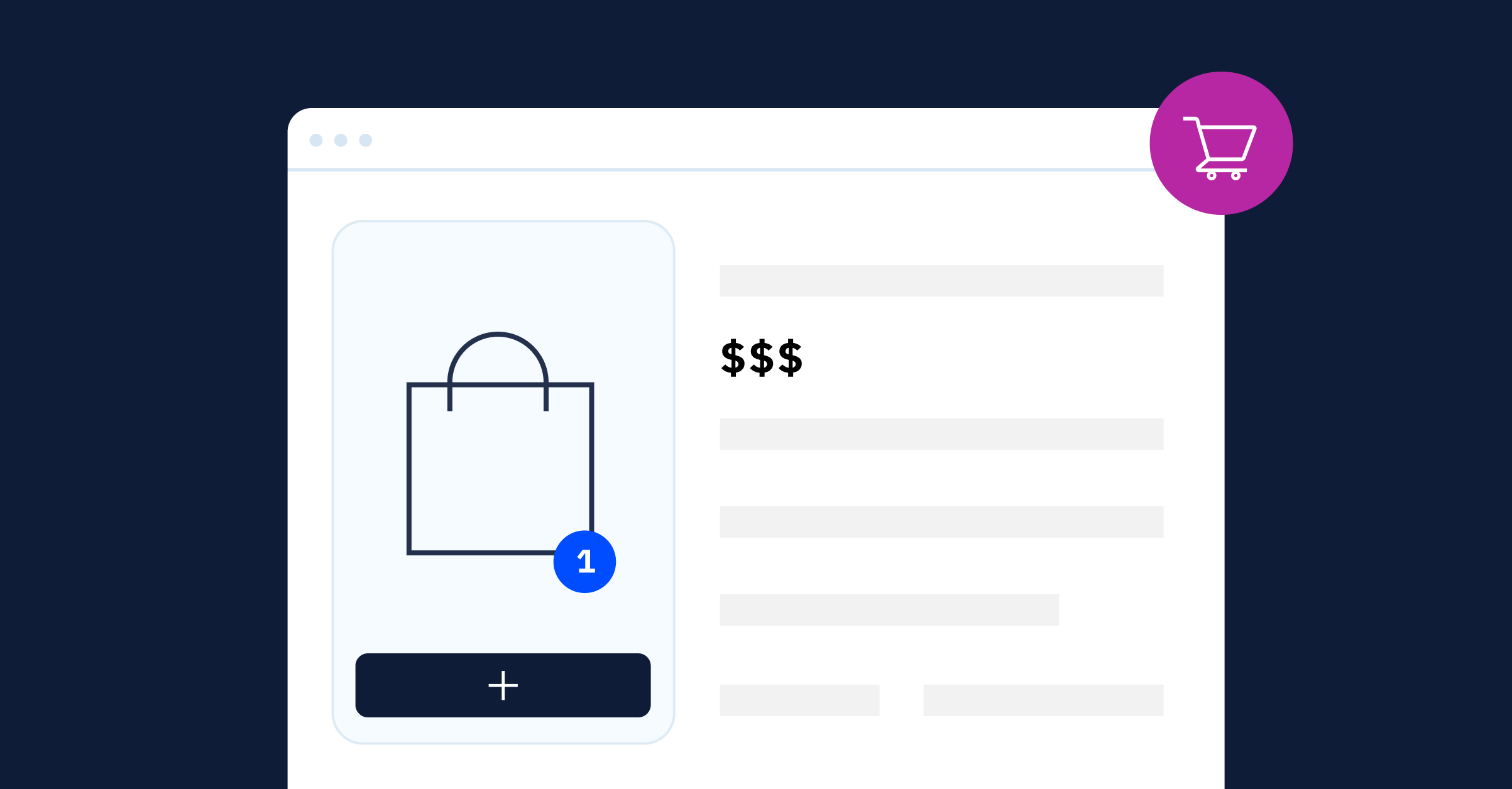Almost 50% of organizations started using a marketing automation platform for the first time within the last four years.
While 86% of marketing professionals are familiar with the concept of marketing automation, only 20% of companies are using automation to its fullest potential. That difference of 66% is the gap between companies who are wasting time and energy manually executing marketing tasks and companies who have embraced automation, seeing the benefits affect every part of their workstream.
Studies show that 17.4% of marketers see marketing automation as the most effective digital marketing technique, tying with content marketing. Clearly, there’s an interest in incorporating automation into existing marketing workflows. Have you considered it?
This sentiment only grows stronger for e-commerce stores and businesses. The quick rise of e-commerce has made marketers everywhere evaluate their tools and question if they have the right solutions in place to make their work (and the customer experience) seamless throughout the entire buying process. E-commerce is becoming a mainstay and e-commerce brands will only benefit from the implementation of a marketing automation tool.
In this article, we’ll walk through the benefits of e-commerce marketing automation, types of automation, and the strategies you can begin using today to strengthen your e-commerce business.
What is e-commerce marketing automation?
E-commerce marketing automation refers to the use of software tools and technologies to automate repetitive marketing tasks and enhance your business workflows with personalization and smart nurturing to grow your e-commerce business. These tools are designed to streamline, measure, and automate marketing tasks, allowing businesses to increase efficiency, save time, and improve customer engagement.
There are a few key aspects of e-commerce marketing automation:
- Customer segmentation: E-commerce marketing automation software allows businesses to segment their customers based on various criteria such as purchase history, demographics, behavior on the website, and more. By categorizing customers into different segments, businesses can create targeted email marketing campaigns tailored to specific customer groups.
- Email marketing automation: One of the most common uses of marketing automation in e-commerce is email marketing. Businesses can automate email campaigns based on customer behavior, such as abandoned cart emails, product recommendations, follow-up emails after a purchase, and promotional offers. Automation ensures that the right message is delivered to the right person at the right time, increasing the chances of conversions.
- Personalization: E-commerce marketing automation tools often include personalization features. By analyzing customer data and behavior, businesses can create personalized product recommendations and content for individual customers. Personalization enhances the customer experience and can significantly boost sales.
- Behavioral tracking: Marketing automation tools can track customer behavior on e-commerce websites. This behavioral analytics can be used to understand how customers interact with the site, what products they are interested in, how much time they spend on specific pages, and more. Analyzing this data helps businesses make informed decisions about their marketing strategies.
- Social media automation: Social media automation tools can schedule posts, track engagement, and even respond to customer inquiries on social media platforms. This ensures a consistent online presence and helps build a strong social media community around the brand.
- Analytics and reporting: E-commerce marketing automation platforms provide detailed analytics and reports. Businesses can track the performance of their marketing campaigns, measure ROI, and gain insights into customer behavior. Data-driven decisions can then be made to optimize marketing strategies further.
- Workflow automation: Marketing automation tools enable businesses to create automated workflows for various tasks. For example, when a customer makes a purchase, the system can automatically trigger follow-up emails, update inventory, and generate sales reports without manual intervention.
Creating and maintaining an e-commerce store requires you to perform endless manual and time-consuming tasks like sending emails, collecting contact information, generating leads, and consistently engaging with your customers. Without a marketing automation tool in place, this work can eat up precious time and leave room for human error.
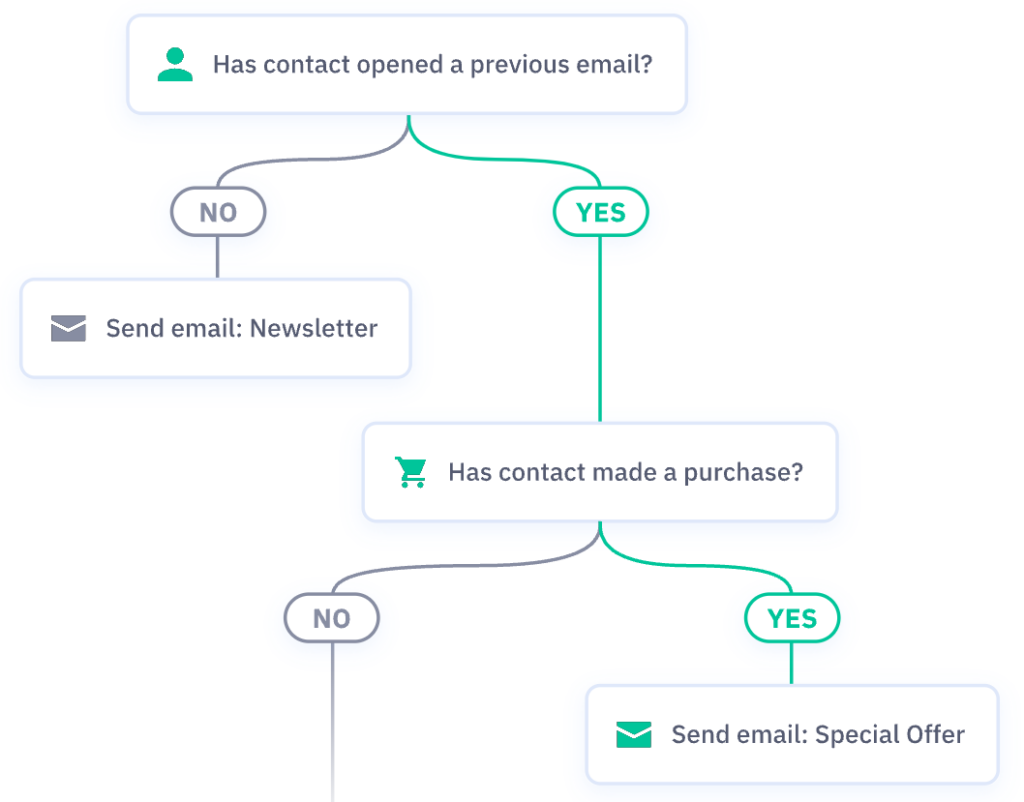
By adopting a good automation tool, you can be sure to engage your contacts when they’re most likely to convert into sales based on the data they gather.
Click here for a list of powerful e-commerce trends you can use to engage your customers.
The benefits of marketing automation software for e-commerce businesses
When you implement e-commerce automation into your business, you’ll see a number of benefits begin to surface one by one. Not only can you create a more efficient and personalized marketing strategy, but you’ll see that automating tasks gives you the power to increase sales and boost customer satisfaction.
Let’s dive deeper into what you can expect as you begin automating.
Improved segmentation capabilities
E-commerce marketing automation simplifies customer segmentation based on preferences and past actions. As your customers engage more with your brand, you gather valuable data to craft targeted campaigns. Automating routine marketing tasks provides insights into their desires, allowing you to offer tailored experiences.
Plus, e-commerce marketing automation enables you to leverage this data for future campaigns, adapting to specific customer interactions. If a customer engages with a campaign, their subsequent interaction can be automated. And if they don’t engage, you can automate a different touchpoint.
ActiveCampaign automatically segments customers for you based on customer behavior:
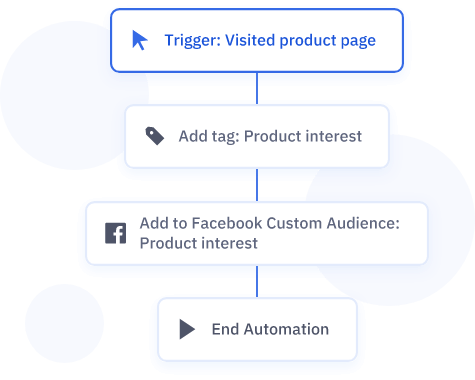
Rather than relying on guesswork or blindly sending campaigns, automated e-commerce marketing ensures direct and personalized communication with your audience, which is what modern customers are looking for. Automation tools are the key to enhancing and scaling your work into the future.
Quicker time to value
Implementing automation software can significantly boost a company’s time to value by streamlining processes and enhancing efficiency. By automating repetitive and time-consuming tasks, businesses can expedite their workflow, enabling them to achieve results faster.
When you set up a workflow automation, it can operate autonomously, ensuring routine tasks are handled without manual intervention. This not only saves time but also reduces the risk of errors, leading to a more streamlined and productive operation.
The time saved through automation provides teams with the opportunity to concentrate on more strategic and creative endeavors. Freed from mundane tasks, employees can invest their energy in making data-driven decisions, crafting compelling campaigns, and exploring new avenues for business growth.
More control over the customer journey
E-commerce marketing automation offers the advantage of effortlessly maintaining customer engagement through real-time triggers. These triggers can be based on different scenarios, behaviors, or specific timelines, and you can program them to send personalized messages at pivotal stages in the customer’s journey.
The level of automation is fully customizable, giving you the flexibility to design automated touchpoints that gently steer your audience toward making a purchase. With the right marketing software, you can create a seamless customer journey and enhance engagement (which will lead to a boost in conversion rates).
Improve customer engagement
An automation solution enables you to send timely and triggered emails to your customers based on their actions. You can establish automated workflows that send distinct emails tailored to individual buyers’ preferences and interests. This is great considering the customer experience can be bland and robotic. The ability to tailor your emails to the buyer liven up the process and can make an impression on them that they won’t soon forget.
For instance, you can create various email sequences for customers who opened your emails, clicked on links, made purchases, or never engaged with the emails. These triggered emails enhance your personalization efforts and contribute to building more meaningful and customized customer experiences.
Get ahead of the game and never miss out on engaging with your customers by downloading our e-commerce calendar, chock full of strategy tips and marketing campaign ideas to help you sell your brand year round.
Build better customer relationships
When you take the time to set up an automation workflow that contains valuable content, personalized offers based on the customer, and ultra-relevant product recommendations, you enhance the entire experience. And who wouldn’t want to do that? The care you inject into your workflows will slowly etch your brand into your customers’ memory, turning a cold prospect into a brand advocate.
Plus, marketing automation systems elevate the customer experience by automating support services, simplifying conflict resolution, and offering assistance effortlessly. Automation allows you to create a robust ticketing system that automatically tracks, manages, and resolves less complex issues. That’s time back in your day to focus on further building your brand.
Improved reporting and analytics
E-commerce marketers who use sophisticated automation systems can precisely track and assess their performance over time, offering a substantial improvement over manual methods.
60% of global companies leverage data to improve existing processes.
These automation platforms provide visual reports of your past activities, offering a clear depiction of your endeavors. This visual representation is invaluable, enabling you to identify weaknesses in your performance and make necessary improvements. By analyzing the available data and insights, you can predict your future progress and receive practical recommendations, enhancing your strategic planning. The data collected by marketing automation tools equips you with valuable insights, empowering you to devise more effective strategies for your e-commerce endeavors.
Types of e-commerce marketing automation
In the world of e-commerce, three types of marketing automation are prevalent. Each has its own purpose when set up, so it’s up to you to decide which will benefit your business the most.
Email marketing automation
Odds are, when you think of marketing automation, you’ll think of email automation first and, there’s a reason why it’s always top of mind. Email is one of the most important mediums to reach your audience. Marketers use email sequences and touchpoints in their campaigns because there are endless ways you can engage using email automation.
The main focus when crafting an email automation strategy is usually personalization and reaching out to the right people at the right time. People like receiving emails, content, and special discounts that are specific to them, so using the data from your automation platform and incorporating it accordingly is a major reason why this type of automation is so popular.
You can even reward specific segments once they’ve performed a specific action (clicked on a webinar link or spent a certain amount of money on your site).
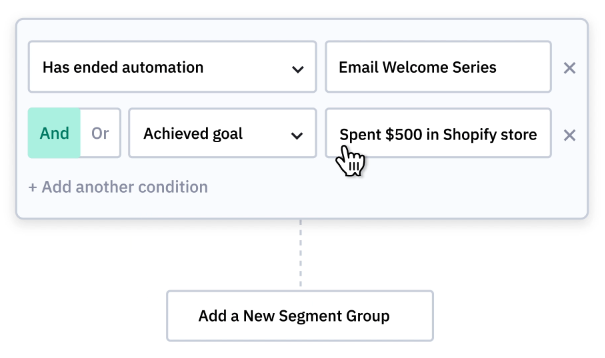
One of the most basic ways to personalize your emails is by personalizing the subject line, how you address the recipient, and the call to action included at the end. In fact, research shows that personalized CTAs convert 202% better than basic CTAs, which is motivation enough to lean into personalization.
There are many more ways to automate your entire campaign workflow, including follow-up emails and special offers. These things make your customers feel taken care of and appreciated when you bake them into your email sequences.
Need a bit of inspiration? Try our email subject line generator and start personalizing your subject lines today.
Mobile marketing automation
Another type of automation is mobile marketing automation. Did you know that 85% of American men and women own a smartphone, and approximately 98% of women and 97% of men own a cell phone? With the vast majority of people using phones, creating a mobile marketing strategy could be a consideration for your business.
Communicating with customers via text and push notifications is a worthwhile endeavor. With mobile marketing automation, you can set up an automated workflow that collects customer data, sends product-specific messages via SMS messaging, keeps them engaged with your brand, and guides the perfect customer journey.
On-site marketing automation
Focusing on automating your marketing channels is crucial, but optimizing your website holds equal importance. Crafting the ideal customer journey is key, especially considering that 80% of consumers are more likely to buy from brands that offer more personalized experiences.
Incorporating well-designed landing pages, strategic web players, and relevant content pieces can significantly influence your audience to take action, and your marketing automation software serves as a valuable tool in streamlining these efforts.
Automated marketing tools empower you to make informed, data-driven decisions regarding the unique content displayed to each customer. Instead of relying on guesswork to predict which blog or product category might appeal to them, you can automate suggestions based on their past actions, ensuring a tailored experience that resonates with their preferences.
Effective marketing automation strategies for e-commerce brands
Once you’ve decided which type (or types) of automation are right for your e-commerce business, there are dozens of strategies to elevate the entire workflow and wow your customers.
Craft dynamic, personalized content
We’ve been touching on personalization a lot, but it’s important! It can help you send relevant and valuable information to your customers based on their purchase history, preferences, demographic data, and the content they’ve already engaged with. All of this combined shows your customers that you care and see them as an individual among the rest.
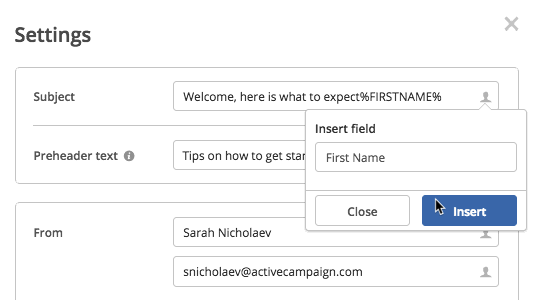
Let’s say you run a homewares e-commerce store and a customer purchases a set of plates. You can set up an automation that brings anyone who purchased plates into a workflow that follows up with an offer or upsell on bowls and cups. The customer receives relevant information and you have a better chance of making another sale.
Segment your email lists
Speaking of personalization, we need to talk about segmentation. Segmentation involves categorizing your customers into distinct groups and sending customized email sequences that cater to their individual preferences. For example, a new customer may be sent a welcome email while an older customer (let’s say someone who hasn’t been engaging with emails) may be sent a re-engagement campaign to spark their interest again.
Even though these customers are in the same audience, they’re very different and require different tactics to engage them. This is why segmenting your email list is so crucial to elevating the customer experience.
Use email triggers to your advantage
Did you know that 82% of marketers use automation to create triggered emails?
Email triggers, also known as triggered emails, are automated email messages sent in response to specific actions or events taken by recipients. These actions or events, such as signing up for a newsletter, making a purchase, abandoning a shopping cart, or clicking on a particular link, serve as triggers for the automated email system. When the trigger event occurs, the system automatically sends a pre-defined email to the recipient, tailored to the context of their action.
There are a number of emails you can send when a customer activates a trigger:
- Welcome emails: Welcome emails are usually the first touchpoint for any customer. They’re most commonly activated when a potential customer signs up for a newsletter, completes a form on a landing page, or makes their first purchase. Be sure to design an interactive welcome email that serves a purpose.
- Reminder and follow-up emails: These emails are typically your order confirmation email, shipping confirmation email, or some form of upsell email. They nurture the lead, communicate necessary information the customer needs (for example: tracking information), and give you as an e-commerce brand the opportunity to follow up with an upsell and suggest additional products they may be interested in.
- Birthday offers: Send your customers a special discount code or voucher for a free product or service on their birthday. And here’s a tip: let them know it’s coming before their birthday arrives so they’ll be on the lookout for your email in anticipation of their birthday gift.
- Abandoned cart emails: Use this trigger to re-engage customers who abandoned products in their cart. You can include an incentive like a discounted price if you’re looking to capture their sale.
- Lead nurturing: This may be the most important step, so listen up. Once you welcome your lead, it’s crucial to keep them interested and updated by sharing helpful content about your brand. This lead nurturing could be promoting new products, sending free assets or content relevant to your audience, etc. It’s a great way to keep cold leads warm (and hopefully hot).
Re-engagement and win-back campaigns
Speaking of cold leads, a re-engagement or win-back email campaign could be the perfect solution to warming them up again. When a customer stops interacting with your brand or purchasing as they used to, you can mark them as disengaged in your marketing automation platform and fold them into a reactivation email campaign.
A win-back email is a great way to recapture the attention of straying customers and give them a reason to care about (and purchase from) your brand again.
Practice lead scoring
No two leads are the same. One may be ready to buy today, while the other may need consistent content and prompting to eventually make a purchase. When you enlist the help of a marketing automation tool, you’ll have insight into the actions a customer took and focus your attention on the leads that are ready to buy. Automation makes lead scoring that much easier.
This doesn’t mean you should neglect customers who have disappeared. Some of them may be ghosts for a long time. Still, you should create an email sequence for these leads so they can stay updated and engage when they’re ready. A good marketing automation platform can pinpoint sales-ready leads by monitoring, categorizing, and evaluating them according to their actions and interests. This will enable you to send high-quality leads to your sales teams and streamline the conversion process.
Marketing automation software is key for e-commerce stores
As e-commerce grows and evolves, it’s imperative for e-commerce business owners and marketers to proactively stay ahead of the curve. Maintaining existing customer relationships and preventing customer loss are crucial for the growth of your business.
E-commerce marketing automation stands out as the smartest choice. The time saved by automating various tasks can be redirected towards more meaningful and strategic work. The greater the number of tasks you can automate, the more efficient your operations become.
The choice is yours
An automation platform can have great reviews, but if it doesn’t address your specific pain points, it can affect (and even stunt) your growth. There are dozens of options available to marketers, ranging from specialized software that can be integrated into a technology stack to comprehensive solutions that offer all necessary tools in one convenient package.
There are many e-commerce platforms to help you automate your workflows, but allow us to suggest ActiveCampaign as the solution for you. Able to do everything in this blog post and more, ActiveCampaign gives you the power to nurture your customers and make meaningful connections turn into brand advocates, word-of-mouth marketing, and steady revenue for your e-commerce business.
Want a look into the platform? Sign up for a free trial below!
Try ActiveCampaign, free
No credit card required. Instant set-up.
